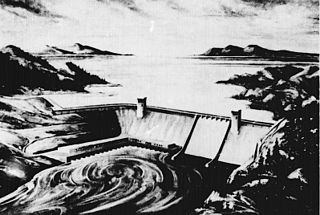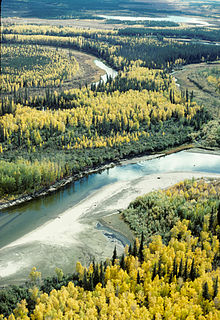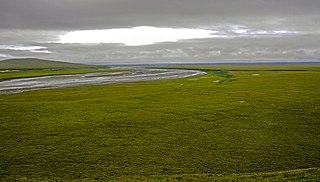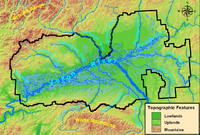
The Arctic National Wildlife Refuge is a national wildlife refuge in northeastern Alaska, United States on Gwich'in land. It consists of 19,286,722 acres (78,050.59 km2) in the Alaska North Slope region. It is the largest national wildlife refuge in the country, slightly larger than the Yukon Delta National Wildlife Refuge. The refuge is administered from offices in Fairbanks. ANWR includes a large variety of species of plants and animals, such as polar bears, grizzly bears, black bears, moose, caribou, wolves, eagles, lynx, wolverine, marten, beaver and migratory birds, which rely on the refuge.

Yukon–Koyukuk Census Area is a census area in the U.S. state of Alaska. As of the 2020 census, the population was 5,343, down from 5,588 in 2010. With an area of 147,842.51 sq mi (382,910.3 km2), it is the largest of any county or county-equivalent in the United States, or about the same size as the state of Montana. It is part of the unorganized borough of Alaska and therefore has no borough seat. Its largest communities are the cities of Galena, in the west, and Fort Yukon, in the northeast.

Soldotna is a city in the Kenai Peninsula Borough in the U.S. state of Alaska. At the 2020 census, the population was 4,342, up from 4,163 in 2010. It is the seat of the Kenai Peninsula Borough.

Fort Yukon is a city in the Yukon-Koyukuk Census Area in the U.S. state of Alaska, straddling the Arctic Circle. The population, predominantly Gwich'in Alaska Natives, was 583 at the 2010 census, down from 595 in 2000.

The Alaska National Interest Lands Conservation Act (ANILCA) is a United States federal law signed by President Jimmy Carter on December 2, 1980. ANILCA provided varying degrees of special protection to over 157,000,000 acres (64,000,000 ha) of land, including national parks, national wildlife refuges, national monuments, wild and scenic rivers, recreational areas, national forests, and conservation areas. It was, and remains to date, the single largest expansion of protected lands in history and more than doubled the size of the National Park System.

The Innoko National Wildlife Refuge is a national wildlife refuge of the United States located in western Alaska. It consists of 3,850,481 acres (15,582 km2), of which 1,240,000 acres (5,018 km2) is designated a wilderness area. It is the fifth-largest national wildlife refuge in the United States. The refuge is administered from offices in Galena.

Beaver Creek is a 180-mile (290 km) tributary of the Yukon River in the U.S. state of Alaska. The creek begins at the confluence of Champion and Bear creeks in the White Mountains National Recreation Area, about 50 miles (80 km) north of Fairbanks. From there it flows west around the southern end of the White Mountains, then northeast into the Yukon Flats National Wildlife Refuge, then west into the Yukon River downstream of Beaver.

The Yukon–Kuskokwim Delta is a river delta located where the Yukon and Kuskokwim rivers empty into the Bering Sea on the west coast of the U.S. state of Alaska. At approximately 129,500 square kilometers (50,000 sq mi) in size, it is one of the largest deltas in the world. It is larger than the Mississippi River Delta ; it is comparable in size to the entire U.S. state of Louisiana. The delta, which consists mainly of tundra, is protected as part of the Yukon Delta National Wildlife Refuge.

The Porcupine caribou or Grant's caribou is a subspecies of the reindeer or caribou found in Alaska, United States, and Yukon and the Northwest Territories, Canada. It resembles the subspecies known as the barren-ground caribou and is sometimes included in it.

The Yukon Delta National Wildlife Refuge is a United States National Wildlife Refuge covering about 19.16 million acres (77,500 km2) in southwestern Alaska. It is the second-largest National Wildlife Refuge in the country, only slightly smaller than the Arctic National Wildlife Refuge. It is a coastal plain extending to the Bering Sea, covering the delta created by the Yukon and Kuskokwim rivers. The delta includes extensive wetlands near sea level that are often inundated by Bering Sea tides. It is bordered on the east by Wood-Tikchik State Park, the largest state park in the United States. The refuge is administered from offices in Bethel.

The National Petroleum Reserve in Alaska (NPRA) is an area of land on the Alaska North Slope owned by the United States federal government and managed by the Department of the Interior, Bureau of Land Management (BLM). It lies to the west of the Arctic National Wildlife Refuge, which, as a U.S. Fish and Wildlife Service managed National Wildlife Refuge, is also federal land.

Alaska occupies the northwestern portion of the North American continent and is bordered only by Canada on the east. It is one of two U.S. states not bordered by another state; Hawaii is the other. Alaska has more ocean coastline than all of the other U.S. states combined. About 500 miles (800 km) of Canadian territory separate Alaska from Washington state. Alaska is thus an exclave of the United States that is part of the continental U.S. and the U.S. West Coast, but is not part of the contiguous U.S. Alaska is also the only state, other than Hawaii, whose capital city is accessible only via ship or air, because no roads connect Juneau to the rest of the continent.

The Rampart Dam or Rampart Canyon Dam was a project proposed in 1954 by the U.S. Army Corps of Engineers to dam the Yukon River in Alaska for hydroelectric power. The project was planned for Rampart Canyon just 31 miles (50 km) southwest of the village of Rampart, Alaska and about 105 miles (169 km) west-northwest of Fairbanks, Alaska.

The Yukon Flats National Wildlife Refuge is a protected wetland area in the U.S. state of Alaska. It encompasses most of the Yukon Flats, a vast wetland area centered on the confluence of the Yukon River, Porcupine River, and chandler
The Alaska Conservation Society was the first grassroots environmental conservation group in the U.S. state of Alaska. It was founded in 1960 to coordinate opposition to Project Chariot, a plan to blast a harbor at Point Hope, Alaska, using nuclear explosions. The group subscribed to environmental preservation and the principles of conservation. After the defeat of Project Chariot, the group decided to fight the proposed Rampart Dam project on the Yukon River. After succeeding, the society took a stance on the development of the Trans-Alaska Pipeline System, encouraging environmental mitigation during and after its construction. This led to the society becoming a major factor in environmental policy within the state. The group operated between 1960 and 1993 and was superseded by the Alaska Conservation Foundation, which was founded in 1980 and still operates today.

The Koyukuk National Wildlife Refuge is a 3,500,000-acre (14,000 km2) conservation area in Alaska. It lies within the floodplain of the Koyukuk River, in a basin that extends from the Yukon River to the Purcell Mountains and the foothills of the Brooks Range. This region of wetlands is home to fish, waterfowl, beaver and Alaskan moose, and wooded lowlands where two species of fox, bears, wolf packs, Canadian lynx and marten prowl.

The interior Alaska–Yukon lowland taiga is an ecoregion in the taiga and boreal forests biome, of far northern North America.

The Arctic coastal tundra is an ecoregion of the far north of North America, an important breeding ground for a great deal of wildlife.

The Beringia lowland tundra is a tundra ecoregion of North America, on the west coast of Alaska, mostly covered in wetland.

Climate change in Alaska encompasses the effects of climate change in the U.S. state of Alaska.




















